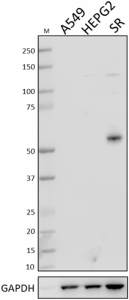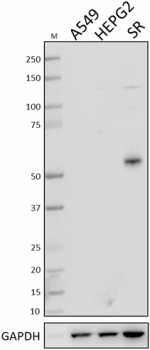- Clone
- 4F3-3C8-2B7 (See other available formats)
- Regulatory Status
- RUO
- Other Names
- RORc, Nuclear receptor ROR-gamma, Nuclear receptor RZR-gamma
- Isotype
- Mouse IgG1, κ
- Ave. Rating
- Submit a Review
- Product Citations
- publications

-

Total cell lysates (15 µg total protein) from A549, HepG2 (negative controls) and SR (positive control) cells were resolved by 4-12% Bis-Tris gel electrophoresis, transferred to a nitrocellulose membrane, and probed with 1.0 µg/mL of Purified anti-RORγ Antibody, clone 4F3-3C8-2B7, overnight at 4°C. Proteins were visualized by chemiluminescence detection using HRP goat anti-mouse IgG Antibody (Cat. No. 405306) at a 1:3000 dilution. Direct-Blot™ HRP anti-GAPDH Antibody (Cat. No. 607904) was used as a loading control at a 1:50000 dilution (lower). Lane M: Molecular Weight marker. -
Nuclerar extract from mouse thymus was resolved by electrophoresis, transferred to nitrocellulose and probed with purified 4F3-3C8-2B7. Proteins were visualized using goat anti-mouse secondary antibody conjugated to HRP and a chemiluminescent system.
| Cat # | Size | Price | Quantity Check Availability | Save | ||
|---|---|---|---|---|---|---|
| 644902 | 100 µg | 235€ | ||||
RORγ (Retinoid-related orphan receptor gamma) belongs to the nuclear hormone receptor family, NR1 subfamily. Contains 1 nuclear receptor DNA-binding domain. RORγ has two isoforms: γ1 and γ2 (also referred to as RORγt). The RORγt differs from the RORγ1 isoform in that it lacks the amino terminus of RORγ1. RORγ1 contains 516 amino acids and RORγt contains 495 amino acids. RORγ1 has a molecular weight of approximately 58 kD. RORγ1 is highly expressed in thymus, kidney, liver, muscle, and brown fat but not in white fat tissue. RORγt is specifically expressed in only two cell populations, DP thymocytes and lymphoid tissue inducers (LTi). RORγ plays a critical role in control apoptosis during thymopoiesis and T cell homeostasis. RORγ is to regulate TCRα repertoire by virtue of its positive regulatory role on Bcl-x expression. RORγ is essential for lymph nodes and Peyers patches development.
Product DetailsProduct Details
- Verified Reactivity
- Human
- Reported Reactivity
- Mouse
- Antibody Type
- Monoclonal
- Host Species
- Mouse
- Immunogen
- Human RORγ-GST recombinant protein
- Formulation
- Phosphate-buffered solution, pH 7.2, containing 0.09% sodium azide.
- Preparation
- The antibody was purified by affinity chromatography.
- Concentration
- 0.5 mg/ml
- Storage & Handling
- The antibody solution should be stored undiluted between 2°C and 8°C.
- Application
-
WB - Quality tested
- Recommended Usage
-
Each lot of this antibody is quality control tested by Western blotting. Western blotting, suggested working dilution: 1 to 4 µg/ml. It is recommended that the reagent be titrated for optimal performance for each application.
- Application Notes
-
This product weakly reacts with Mouse.
- Application References
-
- Klemann C, et al. 2009. Am J Pathol. 174:2234. PubMed
- Product Citations
-
- RRID
-
AB_1595502 (BioLegend Cat. No. 644902)
Antigen Details
- Structure
- Belongs to the nuclear hormone receptor family, NR1 subfamily. Contains 1 nuclear receptor DNA-binding domain. RORγ has two isoforms: γ1 and γ2 (also referred to as RORγt). The RORγt differs from the RORγ1 isoform in th
- Distribution
-
Th17 cells
- Function
- RORγt is essential for lymph nodes and Peyer's patches development. RORγt plays a critical role in control apoptosis during thymopoiesis and T cell homeostasis.
- Cell Type
- Th17
- Biology Area
- Cell Biology, Immunology
- Molecular Family
- Nuclear Markers
- Antigen References
-
1. Medvedev A, et al. 1997. Genomics 46:93.
2. He YW, et al. 1998. Immunity 9:797.
3. Eberl G, et al. 2004. Nat. Immunol. 5:64. - Gene ID
- 19885 View all products for this Gene ID
- UniProt
- View information about RORgamma on UniProt.org
Related Pages & Pathways
Pages
Related FAQs
Other Formats
View All RORγ Reagents Request Custom Conjugation| Description | Clone | Applications |
|---|---|---|
| Purified anti-RORγ | 4F3-3C8-2B7 | WB |
Compare Data Across All Formats
This data display is provided for general comparisons between formats.
Your actual data may vary due to variations in samples, target cells, instruments and their settings, staining conditions, and other factors.
If you need assistance with selecting the best format contact our expert technical support team.

 Login / Register
Login / Register 










Follow Us